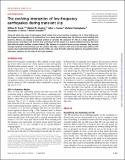The evolving interaction of low-frequency earthquakes during transient slip
Author(s)
Shapiro, N. M.; Husker, A. L.; Kostoglodov, V.; Gusev, A. A.; Campillo, M.; Frank, William B; ... Show more Show less
Downloade1501616.full.pdf (2.108Mb)
PUBLISHER_POLICY
Publisher Policy
Article is made available in accordance with the publisher's policy and may be subject to US copyright law. Please refer to the publisher's site for terms of use.
Terms of use
Metadata
Show full item recordAbstract
Observed along the roots of seismogenic faults where the locked interface transitions to a stably sliding one, low-frequency earthquakes (LFEs) primarily occur as event bursts during slow slip. Using an event catalog from Guerrero, Mexico, we employ a statistical analysis to consider the sequence of LFEs at a single asperity as a point process, and deduce the level of time clustering from the shape of its autocorrelation function. We show that while the plate interface remains locked, LFEs behave as a simple Poisson process, whereas they become strongly clustered in time during even the smallest slow slip, consistent with interaction between different LFE sources. Our results demonstrate that bursts of LFEs can result from the collective behavior of asperities whose interaction depends on the state of the fault interface.
Date issued
2016-04Department
Massachusetts Institute of Technology. Department of Earth, Atmospheric, and Planetary SciencesJournal
Science Advances
Publisher
American Association for the Advancement of Science (AAAS)
Citation
Frank, W. B. et al. “The Evolving Interaction of Low-Frequency Earthquakes During Transient Slip.” Science Advances 2, 4 (April 2016): e1501616–e1501616 © 2016 The Authors
Version: Final published version
ISSN
2375-2548